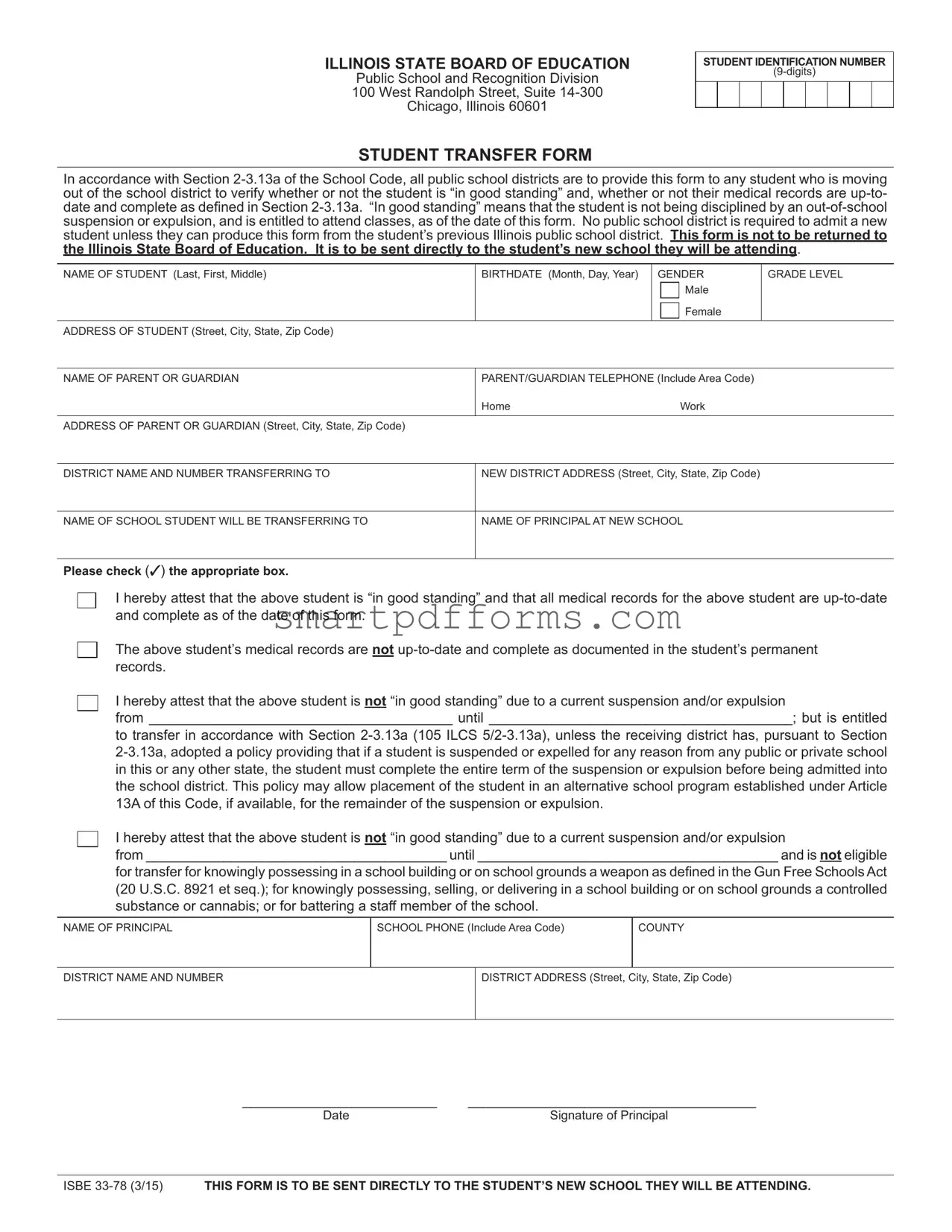ILLINOIS STATE BOARD OF EDUCATION
Public School and Recognition Division
100 West Randolph Street, Suite 14-300
Chicago, Illinois 60601
STUDENT IDENTIFICATION NUMBER
(9-digits)
STUDENT TRANSFER FORM
In accordance with Section 2-3.13a of the School Code, all public school districts are to provide this form to any student who is moving out of the school district to verify whether or not the student is “in good standing” and, whether or not their medical records are up-to- date and complete as deined in Section 2-3.13a. “In good standing” means that the student is not being disciplined by an out-of-school suspension or expulsion, and is entitled to attend classes, as of the date of this form. No public school district is required to admit a new student unless they can produce this form from the student’s previous Illinois public school district. This form is not to be returned to the Illinois State Board of Education. It is to be sent directly to the student’s new school they will be attending.
NAME OF STUDENT (Last, First, Middle) |
BIRTHDATE (Month, Day, Year) |
GENDER |
GRADE LEVEL |
|
|
Male |
|
|
|
Female |
|
ADDRESS OF STUDENT (Street, City, State, Zip Code) |
|
|
|
|
|
|
NAME OF PARENT OR GUARDIAN |
PARENT/GUARDIAN TELEPHONE (Include Area Code) |
|
|
Home |
Work |
|
ADDRESS OF PARENT OR GUARDIAN (Street, City, State, Zip Code) |
|
|
|
|
|
|
DISTRICT NAME AND NUMBER TRANSFERRING TO |
NEW DISTRICT ADDRESS (Street, City, State, Zip Code) |
|
|
|
|
NAME OF SCHOOL STUDENT WILL BE TRANSFERRING TO |
NAME OF PRINCIPAL AT NEW SCHOOL |
|
|
|
|
|
Please check () the appropriate box.
I hereby attest that the above student is “in good standing” and that all medical records for the above student are up-to-date and complete as of the date of this form.
The above student’s medical records are not up-to-date and complete as documented in the student’s permanent records.
I hereby attest that the above student is not “in good standing” due to a current suspension and/or expulsion
from _______________________________________ until _______________________________________; but is entitled
to transfer in accordance with Section 2-3.13a (105 ILCS 5/2-3.13a), unless the receiving district has, pursuant to Section 2-3.13a, adopted a policy providing that if a student is suspended or expelled for any reason from any public or private school in this or any other state, the student must complete the entire term of the suspension or expulsion before being admitted into the school district. This policy may allow placement of the student in an alternative school program established under Article 13A of this Code, if available, for the remainder of the suspension or expulsion.
I hereby attest that the above student is not “in good standing” due to a current suspension and/or expulsion
from _______________________________________ until _______________________________________ and is not eligible
for transfer for knowingly possessing in a school building or on school grounds a weapon as deined in the Gun Free Schools Act (20 U.S.C. 8921 et seq.); for knowingly possessing, selling, or delivering in a school building or on school grounds a controlled substance or cannabis; or for battering a staff member of the school.
SCHOOL PHONE (Include Area Code)
DISTRICT ADDRESS (Street, City, State, Zip Code)
_________________________ |
_____________________________________ |
Date |
Signature of Principal |
ISBE 33-78 (3/15) THIS FORM IS TO BE SENT DIRECTLY TO THE STUDENT’S NEW SCHOOL THEY WILL BE ATTENDING.

